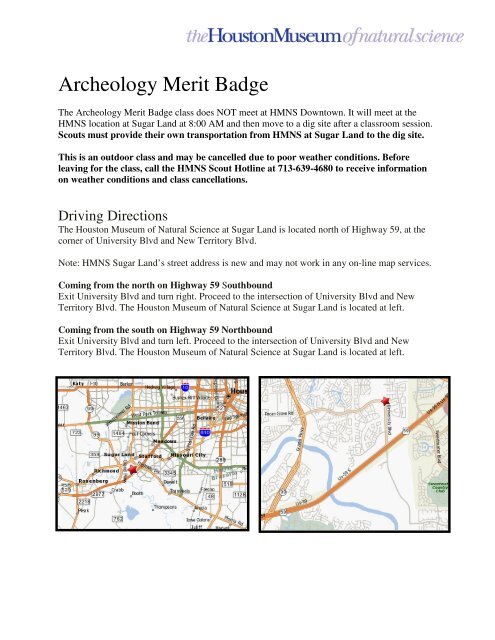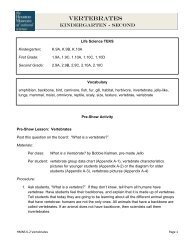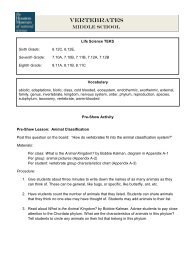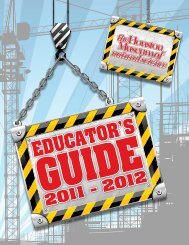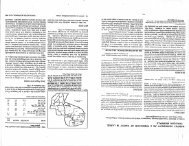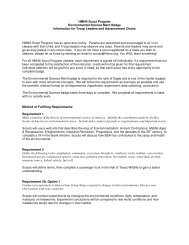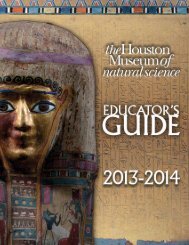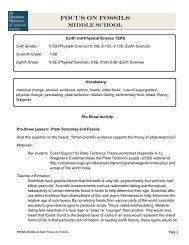Archeology Merit Badge - HMNS
Archeology Merit Badge - HMNS
Archeology Merit Badge - HMNS
You also want an ePaper? Increase the reach of your titles
YUMPU automatically turns print PDFs into web optimized ePapers that Google loves.
<strong>Archeology</strong> <strong>Merit</strong> <strong>Badge</strong><br />
The <strong>Archeology</strong> <strong>Merit</strong> <strong>Badge</strong> class does NOT meet at <strong>HMNS</strong> Downtown. It will meet at the<br />
<strong>HMNS</strong> location at Sugar Land at 8:00 AM and then move to a dig site after a classroom session.<br />
Scouts must provide their own transportation from <strong>HMNS</strong> at Sugar Land to the dig site.<br />
This is an outdoor class and may be cancelled due to poor weather conditions. Before<br />
leaving for the class, call the <strong>HMNS</strong> Scout Hotline at 713-639-4680 to receive information<br />
on weather conditions and class cancellations.<br />
Driving Directions<br />
The Houston Museum of Natural Science at Sugar Land is located north of Highway 59, at the<br />
corner of University Blvd and New Territory Blvd.<br />
Note: <strong>HMNS</strong> Sugar Land’s street address is new and may not work in any on-line map services.<br />
Coming from the north on Highway 59 Southbound<br />
Exit University Blvd and turn right. Proceed to the intersection of University Blvd and New<br />
Territory Blvd. The Houston Museum of Natural Science at Sugar Land is located at left.<br />
Coming from the south on Highway 59 Northbound<br />
Exit University Blvd and turn left. Proceed to the intersection of University Blvd and New<br />
Territory Blvd. The Houston Museum of Natural Science at Sugar Land is located at left.
Outside Requirements<br />
Some of the requirements for the <strong>Archeology</strong> badge must be completed outside the class. It is<br />
important that this work is done before the class. If the outside work is not completed, scouts<br />
will need to mail their work to the <strong>HMNS</strong> counselor to receive a completed blue card. Use the<br />
following pages to complete the outside work.<br />
Requirement 4 must be completed before the class. Bring all your work to the class so it can<br />
be checked off by the instructor.<br />
Requirement 4 states:<br />
Do TWO of the following (We will do B and C):<br />
b. Gather research on three archaeological sites that are within the United States. Point out<br />
each site on a map. Explain how each site was discovered. Describe some of the information<br />
from the past that has been found at each site. Explain how the information gained from the<br />
study of these sites answers questions that archaeologists are asking and how the information<br />
may be important for modern people. Compare the relative ages of the sites.<br />
c. Visit an archaeological site and gather research on it. Explain how the site was<br />
discovered. Describe some of the information from the past that has been found at the site.<br />
Explain how the information gained from the study of this site answers questions that<br />
archaeologists are asking and how the information may be important for modern people.<br />
Compare the age of this site with the ages of the other sites you have researched.<br />
To fulfill requirement 4b you will research 3 archeological sites within the U.S. using the internet. Follow<br />
the link on each worksheet page and answer the questions on the worksheet carefully and completely.<br />
Poor answers will result in your work not being accepted and checked off as complete, and you will have<br />
to re-do the work before receiving your badge.
Wilson-Leonard Site<br />
http://tshaonline.org/handbook/online/articles/WW/bbw3.html<br />
Note: B.P. means “before present”. It is the same as saying “years ago”.<br />
Ca. stands for circa, which means “around” or “about”.<br />
A hearth is a cooking pit.<br />
This work must be completed before<br />
attending the class. Bring the completed<br />
worksheet with you to the Friday evening<br />
session.<br />
Where is the site located What state<br />
Who did the first archeologists that studied the site work for<br />
How deep is the site, and how many years are recorded in the site<br />
What was found at the site (List at least 6 things)<br />
What do you think the people did that lived in the area<br />
What did they eat<br />
Why is it important to study a site that has artifacts at different levels in the ground
Sand Canyon Pueblo Site<br />
http://www.crowcanyon.org/EducationProducts/peoples_mesa_verde/intro.asp<br />
This site will give you a description of the groups of people<br />
that have lived in the area over thousands of years. Use the<br />
links on the top of the page to see the time periods. Then<br />
click the links to the left to fill in the chart.<br />
This work must be completed before<br />
attending the class. Bring the completed<br />
worksheet with you to the Friday evening<br />
session.<br />
Paleoindian<br />
Archaic<br />
Date Range Food Housing Artifacts<br />
<br />
<br />
<br />
Basketmaker II<br />
<br />
<br />
Basketmaker III<br />
Pueblo I<br />
<br />
<br />
Pueblo II<br />
Pueblo III<br />
<br />
<br />
<br />
http://www.crowcanyon.org/ResearchReports/SiteTesting/Text/Report.asp<br />
This is site testing report for the Sand Canyon Archeological Site, and it contains only some the<br />
information known about the site. This is a HUGE amount of information! Click on “List of<br />
Illustrations”. Take a look at images 1.5, 2.7, 5.17, 9.13, and 9.4 to see what the buildings look<br />
like.<br />
http://www.neartime.com/ruins/CrowRockArt.htm<br />
This is some rock art in the sand canyon area.
Spiro Mounds<br />
http://www.texasindians.com/caddo.htm<br />
This work must be completed before<br />
attending the class. Bring the completed<br />
worksheet with you to the Friday evening<br />
session.<br />
What were the two main groups of Caddo Indians and where did they live<br />
What does the word Texas (Tejas) mean<br />
Where They Lived: Describe the environment they lived in.<br />
Houses: What material did they use to build their houses<br />
Draw a Caddo house.<br />
What kind of furniture did they have<br />
Food: How did they get food and what did they eat<br />
Skip to bottom of the web page and click “GO TO PAGE TWO”.<br />
Clothing and Appearance: Name two materials their clothes were made from. How did they<br />
decorate themselves<br />
Religion: Why did the Caddo build mounds<br />
Describe the “busk” and fire ritual.
Requirement 11b states:<br />
Research settlers or soldiers who were in your area at least one hundred years ago. Find out<br />
about the houses or forts, ways of life, clothing styles, arts and crafts, and dietary habits of the<br />
early settlers, farmers, ranchers, soldiers, or townspeople who once lived in the area where your<br />
community now stands. Describe what you would expect to find at an archaeological site for<br />
these people.<br />
Our dig site is at the George Ranch Historical Park. Read the following web site to become<br />
familiar with the park. We will visit the exhibit area of the park to complete this requirement.<br />
http://www.georgeranch.org/visit/general/<br />
The focus of the Ranch is to teach the history of the area and what live was like for the pioneers<br />
in the early days of Fort Bend.<br />
When and where did the first pioneers to Texas settle<br />
The ranch has operated under four family names because it was always passed down to a<br />
daughter. The daughters married and the ranch took on the husband’s family name.<br />
What was the name of the first settlers who farmed in the 1830’s<br />
Who ran the farm after the Civil War<br />
Who ran the farm in the late 1800’s when cattle became big business and the family became very<br />
wealthy<br />
Who were the last descendants of the original Jones family to run the ranch<br />
Read the story of one of the original pioneers of the area.<br />
http://www.texasgenealogy.org/fortbend/james_and_hetty_jones.htm<br />
Other Activities (Not required)<br />
http://research.history.org/Archaeological_Research/KidsPage.cfm<br />
This web site has some games to help you understand archeology. The Stratigraphy Quiz will<br />
help you understand how we learn about artifacts just by looking at the dirt around it. This is a<br />
good one to try before the class because at the dig site you’ll have to do the real thing.
Saturday's Fieldwork<br />
Each scout should bring:<br />
• Plenty of water<br />
• A sack lunch<br />
• Snacks<br />
• Insect repellent<br />
• Clothes and shoes that can get dirty<br />
NO "Class A" uniform<br />
• Sunblock and a hat<br />
• Rain gear (if needed)<br />
The scouts should meet 8:00 Saturday morning at <strong>HMNS</strong> at Sugar Land. After a classroom<br />
session we will move to the dig site at the George Ranch. We will work with members of the<br />
Fort Bend Archeological Society who have been researching the history of the area. Artifact<br />
found during the class will be included in their research.<br />
PARENTS OR TROOP LEADERS SHOULD PLAN TO STAY. Employees of <strong>HMNS</strong> or<br />
the Fort Bend <strong>Archeology</strong> Society will not be responsible for dealing with injuries.<br />
Location of George Ranch.<br />
Parents will need to drive scouts from <strong>HMNS</strong> Sugar Land to the George Ranch.<br />
Click HERE for Mapquest.com map.<br />
George Ranch Historical Park<br />
10215 FM 762 Rd.<br />
Richmond TX 77469<br />
• From <strong>HMNS</strong> Sugar Land go south on University to 59 South, turn onto feeder lanes.<br />
• Turn South onto Crabb River Road.<br />
• Crabb River Road becomes FM 762 / 2759. Continue straight over the railroad tracks.<br />
• Continue on FM 762 until you see the entrance to the George Ranch.
Railroad tracks<br />
George Ranch<br />
Railroad tracks<br />
Allied Concrete<br />
George Ranch


